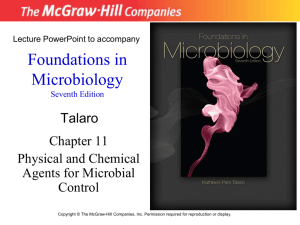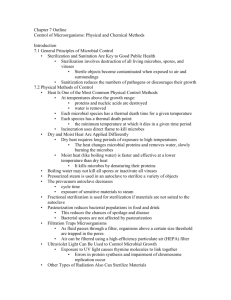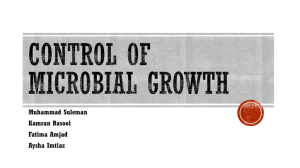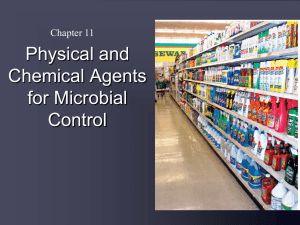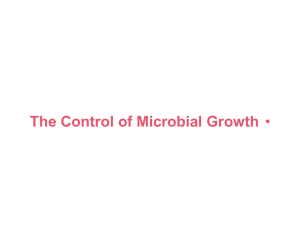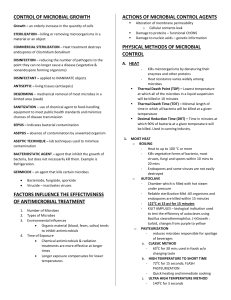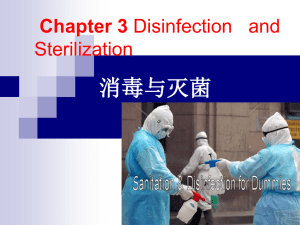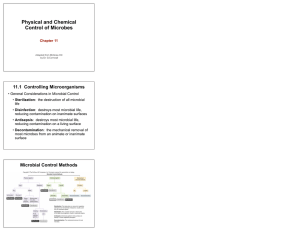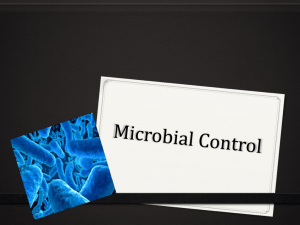Methods for Control of Microbial Growth
advertisement
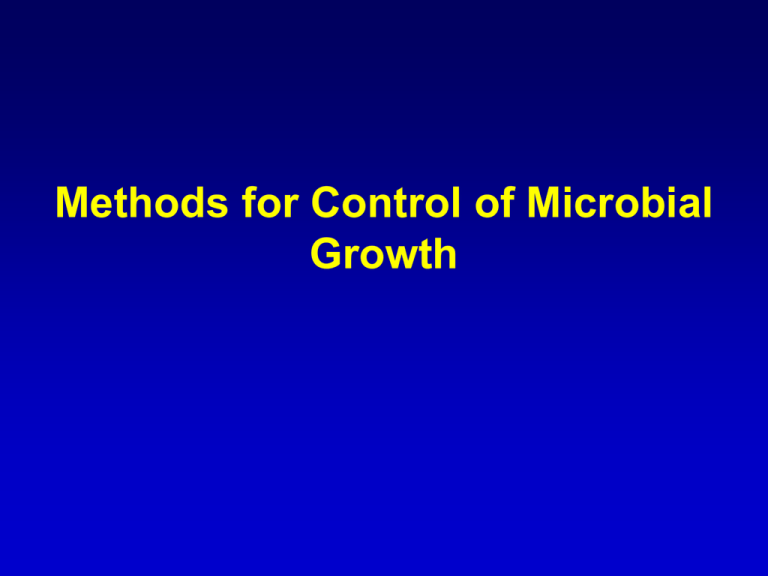
Methods for Control of Microbial Growth Controlling Microorganisms • Physical, chemical, and mechanical methods can be used to destroy or reduce undesirable microbes in a given area • Primary targets are microorganisms capable of causing infection or spoilage: – – – – – vegetative bacterial cells and endospores fungal hyphae and spores, yeasts protozoan trophozoites and cysts worms viruses Hierarchy of Resistance • Most resistant = bacterial endospores • Moderately resistant = cysts, fungal zygospores, naked viruses • Least resistant = vegetative bacterial cells Types of Control • Sterilization – a process that destroys all viable microbes, including viruses and endospores; microbiocidal • Disinfection – a process to destroy vegetative pathogens, not endospores; for inanimate objects • Antisepsis – disinfectants applied directly to exposed body surfaces • Sanitization – any cleansing technique that mechanically removes microbes • Degermation – reduces the number of microbes A Number of Factors Influence the Effectiveness of Control Agents • • • • • • Number of microbes Nature of microbes in the population Temperature and pH of environment Concentration or dosage of agent Mode of action of the agent Presence of solvents, organic matter, or inhibitors Microbiocidals Cause Microbial Death Stasis Agents Slow or Retard Growth, but Do Not Kill Microbes Microbial Death The Permanent Loss of Reproductive Capability Under Optimal Growth Conditions Cellular Targets of Control 1. 2. 3. 4. Cell wall Cell membrane Nucleic Acids (DNA, RNA) Proteins Physical Control Practices Heat-Based Microbial Control Processes • Incineration/ baking achieve sterility • Autoclaving: sterilization with live steam and pressure, very widely used • Pasteurization: flash heat treatment (63°C - 66°C for 30 minutes) that reduces the bio-burden of food materials (kills Salmonella and Listeria) • Boiling disinfection – does not achieve sterility Radiation Sterilization • Ionizing radiation (X-rays, gamma particles) penetrates and damages DNA and other vital cell components • Non-ionizing radiation (UV light) causes adjacent T-T pairs in DNA to fuse • UV has limited penetration; use for surfaces and films of liquids Ultra-filtration • Mechanically excludes organisms from a liquid • Membranes have a specific pore size; any particle larger cannot pass through • Achieves sterilization Filtration Targets of Chemical Agents • Cell Membrane - detergents • Key Proteins – denaturing and crosslinking agents • Nucleic Acids – alkylating and crosslinking agents Halogen Antimicrobials Denature Proteins • Chlorine compounds (gaseous Cl, bleach, chloramine); can be sporicidal • Iodine (tincture, Betadine) • Halogens can react with any organic matter – a surface should be clean before applying them! Phenolics- Disrupt Cell Membranes & Precipitate Proteins • • • • • Phenol Lysol PhisoHex (not any more) Benzalkonium chloride Triclosan Alcohols: Dissolve Membranes and Coagulate Proteins • Ethanol (70%) • Isopropanol • Act as surfactants dissolving membrane lipids and coagulating proteins of vegetative bacterial cells and fungi • Cannot destroy spores at room temperature Hydrogen Peroxide – Attacks DNA and Proteins 3% solution is effective as wound antiseptic, but is potentially damaging to tissues Heavy Metals Mercury, Silver Salts Kill Vegetative Cells Present in low Numbers by Inactivating Proteins Aldehydes – Cross-link DNA and Proteins • Formaldehyde – formalin • Glutaraldehyde - Cidex • A soak of dental or surgical instruments in glutaraldehyde Does Not guarantee sterility! Gases and Aerosols • • • • Ethylene oxide, propylene oxide Strong alkylating agents High level Sterilize and disinfect plastics and prepackaged devices, foods
